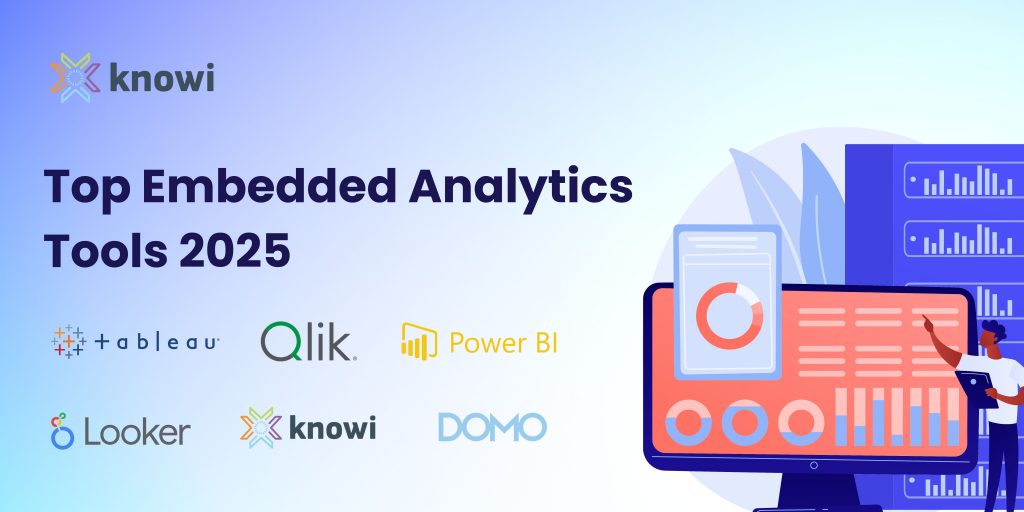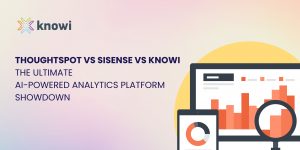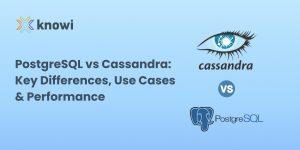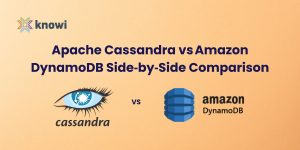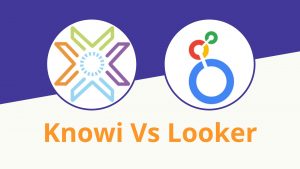TL;DR: Best Embedded Analytics Tools [2025]
Embedded analytics integrates BI directly into apps and workflows, bringing insights to the point of action. In 2025, the top tools stand out as follows:
- Tableau – Polished visualizations, strong Salesforce AI ecosystem, but no native NoSQL and complex embedding.
- Knowi – Best for mixed SQL + NoSQL + unstructured data; smooth embedding with AI-powered insights, white-labeling, and secure SSO.
- Toucan – No-code, fast-deploy platform ideal for SaaS vendors; highly customizable UI but limited for advanced data science.
- Power BI – Deep Microsoft integration, scalable embedding with Copilot AI, but complex pricing/licensing for external users.
- Domo – Cloud-native with unlimited-user model and AI (Domo.AI); wide integrations but high enterprise costs.
- Qlik Sense – Strong AI assistant (Insight Advisor, Qlik Answers), powerful customization, but advanced embedding setup can be complex.
- Looker – Secure, governed enterprise embedding with Duet AI and Google Cloud integration; requires LookML and lacks native NoSQL.
- Embeddable – Developer-first embedded analytics toolkit for SaaS teams, delivering native-feel, blazing-fast dashboards with full code-level control and predictable pricing.
Bottom line:
- Pick Tableau/Power BI/Looker if you’re in those ecosystems.
- Choose Knowi if you need embedded AI + cross-source analytics (SQL, NoSQL, APIs, documents).
- Go with Toucan, Domo, or Embeddable for SaaS-focused embedding. Toucan/Domo for speed with minimal engineering, Embeddable for developer-first, fully native dashboards.
- Use Qlik Sense if you want flexible, AI-driven, governed analytics at scale.
Table of Contents
Introduction
Embedded analytics enables businesses to integrate analytical capabilities directly into their software applications. With embedded analytics, companies can deliver insights exactly where customers need them. Top BI tools today make it easier than ever to embed dashboards, visualizations, and even AI-powered insights right inside the apps and workflows people use every day.
What to Look for in an Embedded Analytics Tool?
As businesses increasingly lean on data-driven insights, embracing an embedded analytics tool becomes paramount. But with so many options available, how do you choose the one that fits just right? Let’s unravel the top considerations to guide your decision:
Native Database Integration
In data analytics, speed is of the essence. Tools that natively integrate with databases, especially powerhouses like MongoDB, offer unparalleled speed and flexibility. On the flip side, tools requiring data movement or additional drivers can introduce latency and complexity, potentially hampering real-time insights.
Data Blending Capabilities
In the complex landscape of modern business, data is scattered across multiple platforms and sources. The ability to seamlessly blend this data provides a holistic view, crucial for businesses juggling diverse data sources.
Customization and White-labeling
Your analytics should feel like an extension of your brand. Tools that offer extensive customization options, from CSS/HTML tweaks to setting default visualization palettes, allow businesses to align analytics with their brand identity. For SaaS providers, white-label solutions can offer an added layer of brand consistency and professionalism.
Scalability
As businesses grow, so do their data and user demands. It’s vital to choose tools that can scale seamlessly to accommodate increasing data volumes and user loads. Cloud-native architectures can also offer flexibility and scalability benefits, ensuring your analytics tool grows with you.
Security and Compliance
Data is valuable, and its security is non-negotiable. Ensuring tools meet industry-specific compliance requirements and offer features like role-based access control, encryption, and audit trails is paramount.
Ease of Use and User Experience
An analytics tool should be accessible to all, not just the tech-savvy. Intuitive interfaces, drag-and-drop functionalities, and easy dashboard creation ensure that even non-technical users can harness the power of data.
Support and Documentation
A robust support system can make the difference between seamless integration and prolonged challenges. Comprehensive tutorials, community forums, and timely customer support responses can significantly enhance the user experience.
Implementation
The ease of implementation can’t be overstated. With custom code samples and options like simple iframe embeds, JavaScript API embeds, and secure URL embeds, the integration process becomes smoother.
Remember, every business is unique and there might be specific needs or considerations pertaining to your operations. Whether it’s cost, integration with other tools, or future roadmap, ensure your chosen tool aligns with your broader business goals. With the right tool, data becomes more than just numbers; it becomes the engine navigating your business towards unrivalled success.
Best Embedded Analytics Tools 2025
Tableau

Tableau is a powerful BI platform from Salesforce that supports advanced embedded analytics and deep AI integrations. With Tableau, users can embed dashboards in portals, apps, or workflows, delivering insights where people work. Salesforce has Einstein Copilot for Tableau (formerly Tableau GPT) and Pulse, which can both now be embedded into other apps.
Features
- Embedded Analytics: Embed dashboards and visualizations using HTML embed codes, Tableau’s JavaScript API, or the new Embedding API v3. Supports Salesforce app embedding, iFrames, white-labeling, and now even Pulse AI insights feed as embeddable components.
- AI Features: Einstein Copilot (conversational assistant for generating visuals and insights), Tableau Pulse (personalized, AI-driven metric monitoring), Ask Data for natural language queries.
- Integrations: Extensive connectors for SQL databases, cloud warehouses, spreadsheets, Salesforce Data Cloud, and more. No native NoSQL connectors.
- Visualizations: Highly customizable dashboards, maps, charts, and stories.
- Cross-Database Joins: Supports joining data from multiple SQL sources.
- Alerts: Email, Slack, and in-app alerts for data thresholds.
- Customer Support: Comprehensive knowledge base, community forum, Salesforce support integration.
Pricing
- Creator: $75/user/month
- Explorer: $42/user/month
- Viewer: $15/user/month
- New: Tableau+ premium bundle (includes AI Copilot, Pulse, Salesforce Data Cloud integration; priced separately, custom quote).
Benefits
- Powerful, secure embedding with modern API support
- Generative AI assistants for easy insights
- Beautiful, interactive visualizations
- Deep Salesforce ecosystem integration
Limitations
- No native NoSQL support (requires third-party connectors)
- Embedding with advanced APIs can be complex
- Legacy elements (Desktop publishing model) still exist
- Requires structured data; limited for unstructured sources
Knowi
Knowi is a unified BI platform specializing in embedded analytics, with strong support for NoSQL and unstructured data. It offers low-overhead, secure embedding for dashboards, charts, and AI-powered analytics.
Features
- Embedded Analytics: Public, token-based, and Single Sign-On (SSO) options. Secure iframe and full-featured JavaScript SDK. White-labeling and multi-tenant support.
- AI Analytics: Auto-generate dashboards, get instant insights, natural language Q&A, Chat with Your Documents, built-in ML models (classification, regression, time series anomaly detection), AI-powered conversational interface that lets users ask questions in plain english.
- Data-as-a-Service: Connects to SQL, NoSQL, REST APIs, cloud warehouses, files. Supports structured, semi-structured, and unstructured data.
- Visualizations: 40+ customizable types, with advanced JavaScript/CSS customization.
- Search-Based Analytics: Natural Language Processing, Slack and Teams integration.
- Multi-Source Joins: Join data across SQL, NoSQL, REST APIs on-the-fly.
- Alerts: Real-time triggers via email, webhook, Slack.
- Customer Support: Knowledge base, release notes, chat system (Zendesk), community forum.
Pricing
- Not publicly listed; custom quotes for Basic, Team, and Enterprise tiers.
- Discounts available for startups and non-profits.
Benefits
- Smooth, secure embedding with SSO and user authentication
- Highly customizable, white-labeled experience
- Native support for SQL, NoSQL, REST APIs, and documents
- Works with unstructured data
- AI-powered insights and conversational analytics
Limitations
- Not open source
- Out-of-the-box visualizations may need customization for aesthetic polish
Toucan

Toucan is a modern embedded analytics platform designed for software vendors and product teams who want to seamlessly integrate dashboards into their applications. Built for fast deployment and easy maintenance, Toucan enables you to deliver insights to your users directly where they need them, with no code and full customization.
Features
- Embedded Analytics: Embed dashboards using iFrames, web component or JavaScript SDK. Supports multi-tenant architecture, granular user access control, row-level security, and full visual customization (themes, logos, fonts, CSS). Works in any front-end framework with fast load times and responsive design.
- AI Features: GPT-based assistant (beta) to suggest commentary on charts and KPIs. Automated insights engine highlights anomalies and variations.
- Integrations: Native connectors for major SQL databases (PostgreSQL, MySQL, BigQuery, Snowflake…), REST APIs, Google Sheets, and Excel. Secure, no-code data preparation layer allows transformations, joins, and filters without SQL.
- Visualizations: Intuitive and guided charts, including bar, line, pie, waterfall, area, maps, KPIs, and more. Built-in filters and drill features. Mobile-first UI for end-user engagement across devices.
- Cross-Database Joins: Combine datasets from different sources directly within Toucan’s data layer—no engineering required.
- Alerts & Sharing: PDF exports, snapshot sharing, scheduled emails. Public and private share links with access control.
- Customer Support: Dedicated Customer Success Manager, onboarding and enablement resources, live support, and detailed documentation.
Pricing
- Free trial available
- Essentials: Starts at $890/month
- Enterprise: Custom quote based on usage
Benefits
- Powerful embedded analytics with minimal engineering effort
- Fully customizable UI and UX to match your product experience
- Fast time-to-value with no-code configuration and instant deployment
- Robust for both internal and external (customer-facing) use cases
- Scalable architecture for multi-tenant SaaS and large deployments
Limitations
- Limited advanced scripting capabilities for data scientists
- Not intended for full-stack ETL or data warehousing
- Some niche chart types (e.g., 3D, statistical plots) not supported
- Less suitable for highly unstructured data sources
Power BI

Power BI by Microsoft is a comprehensive BI tool with deep integration into the Microsoft ecosystem. It offers rich embedding options, now including Copilot AI assistant in embedded reports.
Features
- Embedded Analytics: Secure embed (no-code), Power BI Embedded for advanced developer scenarios. Options for “embed for customers” (no Power BI login) and “embed for organization” (requires login).
- AI Features: Power BI Copilot (generative AI for building visuals and reports from prompts), Q&A for natural language queries, AI visuals (Key Influencers, Decomposition Tree), Azure ML integration.
- Integrations: Hundreds of SaaS and database connectors, deep Microsoft 365 and Azure integration (Excel, Teams, SharePoint, OneLake, Fabric).
- Visualizations: Customizable, interactive charts with drill-down features.
- Alerts: Notifications via email or in Power BI’s notification center.
- Customer Support: Learning resources, community forums, Microsoft Fabric support.
Pricing
- Free plan (for personal use)
- Pro: $10/user/month
- Premium Per User (PPU): $20/user/month
- Premium Capacity: starts ~$4,995/month
- Power BI Embedded: Azure consumption-based pricing
Benefits
- Simple, secure embedding with extensive developer API
- AI-powered Copilot for conversational insights
- Tight integration with Microsoft products
- Scalable pricing from self-service to enterprise
Limitations
- Viewers often need a Power BI license
- Complex UI with steep learning curve
- Limited support for unstructured data
- Embedding for external users typically requires Premium capacity
Domo

Domo is a full-stack cloud-based BI platform offering robust embedded analytics through its Domo Everywhere feature. It’s moving aggressively into AI-powered experiences with Domo.AI.
Features
- Embedded Analytics: No-code and low-code sharing, secure multi-tenant portals, white-label options.
- AI Features: Domo.AI Chat (conversational assistant with “show your work” transparency), Universal Models (prebuilt ML for forecasting, sentiment), AI Model Management, ResponsibleGPT for safe LLM use.
- Integrations: 1,000+ connectors spanning cloud apps, SQL/NoSQL databases, social APIs.
- Visualizations: 150+ customizable types with drag-and-drop creation.
- Alerts: Real-time notifications via text, email, or app.
- Customer Support: Knowledge base, videos, community forum, email, phone.
Pricing
- Free trial (30 days)
- Custom quoted pricing based on data scale and usage capacity
- Unlimited user model (no per-seat charges)
Benefits
- Easy no-code embedding with white-label support
- AI-powered conversational analytics
- Unlimited users with predictable consumption pricing
- Broad integration and automation capabilities
Limitations
- Requires technical setup for custom connectors
- Advanced features can have steep learning curves
- Pricing can be high for enterprise-scale use
Qlik Sense
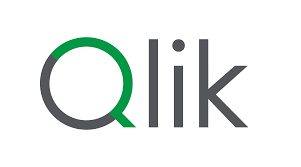
Qlik Sense is a modern BI platform emphasizing interactive, in-memory analytics. Its Qlik Cloud service has moved to capacity-based pricing and emphasizes AI-powered insights with Qlik Answers.
Features
- Embedded Analytics: Flexible APIs, iFrame embedding, Nebula.js for custom visualizations, mashups.
- AI Features: Insight Advisor, Qlik Answers (GenAI chat assistant), AutoML (no-code predictive modeling), natural language generation.
- Integrations: Hundreds of connectors via Connector Factory, tight integration with Talend for data quality, support for SQL/NoSQL, cloud warehouses.
- Visualizations: Fully customizable visuals including charts, treemaps, gauges.
- Search-Based Analytics: Insight Advisor with natural language chat, speech-to-text, Slack/Teams integration.
- Multi-Source Joins: Supports various join types across sources.
- Alerts: Data-driven notifications via email or mobile.
- Customer Support: Knowledge base, chatbot, support portal, community forum.
Pricing
- Starter: ~$200/month (up to 10 users)
- Standard: ~$825/month (unlimited users, 25GB data)
- Premium: ~$2,750/month (50GB data, advanced AI/ML, public embedding)
- Enterprise: Custom pricing
Benefits
- Simple no-code/low-code embedding options
- Powerful GenAI assistant with secure governance
- Supports hundreds of integrations, including unstructured data indexing
- Highly customizable visualizations
- Unlimited user pricing (based on data capacity)
Limitations
- Complex setup for advanced embedding
- Best AI/embedding features in higher tiers
- Users depend on Qlik for new connectors
- High cost for enterprise-scale deployments
Looker

Looker, part of Google Cloud, is an enterprise-grade BI platform focused on governed modeling with strong embedding capabilities. It now includes Duet AI for generative analytics.
Features
- Embedded Analytics: Public, private, SSO embedding via secure iframes. Extension Framework for custom apps. Full API access.
- AI Features: Duet AI assistant (natural language query, auto-generated dashboards, LookML suggestions), integration with Vertex AI for ML scoring.
- Integrations: Native SQL data source support, BigQuery integration, JDBC/ODBC for other SQL systems. Connected Sheets and integration with Google Workspace.
- Visualizations: Customizable charts including gauges, radar, sunburst, bar, area.
- Analytics: Looker Blocks (prebuilt models), semantic modeling with LookML.
- Alerts: Conditional notifications via email or Slack.
- Customer Support: Help page, searchable knowledge base, community forum.
Pricing
- Custom pricing based on users, data scale, and embedding/OEM usage
- Typically enterprise contracts negotiated with Google Cloud
Benefits
- Secure, scalable embedding with SSO
- Tight integration with Google Cloud and Workspace
- Generative AI assistant for natural language querying
- Multi-cloud deployment flexibility
Limitations
- No native NoSQL connectors (SQL warehouse required)
- Poor support for unstructured data
- Requires learning LookML for advanced modeling
- Complex enterprise pricing model
Embeddable

Embeddable, a developer-first analytics toolkit for SaaS teams, delivering blazing-fast, fully native dashboards with both code-level control and a no-code builder for faster shipping.
Features
- Modern Embedded Analytics: Lightweight web components or React/Vue SDKs (no iframes) for seamless UI integration.
- Performance at Scale: Millisecond load times powered by enterprise-grade caching across QA, staging, and production.
- Infinite Customization: Theme every chart at pixel level, extend in code, or import from any React library.
- Developer Tools: Intuitive SDKs, APIs, CI/CD, version control, and secure deployments built for engineering workflows.
- End-User Experience: Self-serve dashboards, drilldowns, localization, export options, and custom views.
- Compatibility: Works with all major SQL databases and supports single-tenant or multi-tenant architectures.
Pricing
- Fixed-price subscription model (no per-user or per-dashboard fees).
- Transparent tiers designed for SaaS teams of all sizes.
- Enterprise options available upon request.
Benefits
- Feels 100% native inside your product (no iframe limitations).
- Blazing-fast dashboards with enterprise-grade performance.
- Infinitely extensible: import your own charts, theme at pixel level.
- Developer-friendly with CI/CD and modern engineering integration.
- Predictable pricing with no usage-based surprises.
Limitations
- Requires some frontend coding for highly bespoke designs.
- Not designed as a general-purpose BI or internal reporting tool.
Final Thoughts
Embedded analytics brings insights directly to the point of action. Tools like Tableau, Knowi, Power BI, Domo, Qlik Sense, and Looker enable companies to deliver interactive dashboards, AI-powered insights, and even natural language Q&A directly inside their software, portals, and apps, enabling faster, smarter decisions exactly where they’re needed.
Ready to embed powerful, AI-driven analytics in your app? Discover what Knowi can do for you today. Book a call with our team today.
Frequently Asked Questions
What is embedded analytics?
Embedded analytics integrates dashboards, reports, and AI insights directly into applications, portals, or workflows so users can access data without leaving their primary tools.
Which are the best embedded analytics tools in 2025?
Leading tools include Tableau, Knowi, Power BI, Domo, Qlik Sense, and Looker, each with different strengths in AI, integrations, and embedding options.
Which embedded analytics tool is best for NoSQL and unstructured data?
Knowi is best for teams working with SQL, NoSQL, APIs, and documents. It natively supports unstructured data and provides AI-powered analytics with secure embedding.
Which tools offer the strongest AI features?
Tableau (Einstein Copilot & Pulse), Power BI (Copilot), Looker (Duet AI), Qlik Sense (Insight Advisor & Qlik Answers), Domo (Domo.AI), and Knowi (secure on-platform AI & conversational analytics) all bring AI into embedded experiences.
What are common limitations of embedded analytics tools?
Tableau/Looker: No native NoSQL support
Power BI: Complex licensing for external users
Knowi: Visuals may need UI customization
Domo: Can be costly at enterprise scale
Qlik Sense: Setup can be complex for advanced embedding
Embeddable: Requires some frontend coding; not designed for internal BI use
